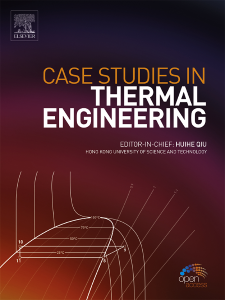Combustion characteristics of a 660 MW tangentially fired pulverized coal boiler considering different loads, burner combinations and horizontal deflection angles
IF 6.4
2区 工程技术
Q1 THERMODYNAMICS
引用次数: 0
Abstract
In the context of transitioning energy structures, thermal power generation is adapting to peak load regulation, highlighting the need for comprehensive studies on boiler combustion characteristics under varying load conditions. This study focuses on a 660 MW tangentially fired boiler, evaluating its combustion and pollutant generation at different operational loads: boiler maximum continuous rate (BMCR), turbine heat acceptance (THA), 75% of THA, and 40% of THA. The findings reveal a general decline in temperature, and nitrogen oxide concentration as the load decreases. However, at 40% THA, increased oxygen mole fractions lead to higher carbon dioxide and sulfur dioxide levels compared to other conditions. Through the Analytic Network Process, each parameter's impact is evaluated and scored to identify the most effective burner and deflection angle combinations. Optimal configurations are identified: a 10-degree rightward adjustment for ABDE layer burners at BMCR and a 10-degree leftward adjustment for BD layer burners at 40% THA, both enhancing combustion performance and reducing pollutants at the furnace outlet. For THA and 75% THA conditions, the industrial standard combination is recommended.考虑到不同负荷、燃烧器组合和水平偏转角,660 兆瓦切向燃烧煤粉锅炉的燃烧特性
在能源结构转型的背景下,火力发电正在适应峰值负荷调节,因此需要对不同负荷条件下的锅炉燃烧特性进行全面研究。本研究以一台 660 兆瓦切向燃烧锅炉为重点,评估了其在不同运行负荷下的燃烧和污染物生成情况:锅炉最大连续率 (BMCR)、汽轮机受热率 (THA)、THA 的 75% 和 THA 的 40%。研究结果表明,随着负荷的降低,温度和氮氧化物浓度普遍下降。然而,与其他条件相比,在 40% THA 条件下,氧分子分数的增加会导致二氧化碳和二氧化硫浓度升高。通过分析网络流程,对每个参数的影响进行评估和评分,以确定最有效的燃烧器和偏转角组合。确定了最佳配置:在 BMCR 条件下,ABDE 层燃烧器向右调整 10 度,在 40% THA 条件下,BD 层燃烧器向左调整 10 度,这两种配置都能提高燃烧性能并减少炉子出口处的污染物。对于 THA 和 75% THA 条件,建议采用工业标准组合。
本文章由计算机程序翻译,如有差异,请以英文原文为准。
求助全文
约1分钟内获得全文
求助全文
来源期刊

Case Studies in Thermal Engineering
Chemical Engineering-Fluid Flow and Transfer Processes
CiteScore
8.60
自引率
11.80%
发文量
812
审稿时长
76 days
期刊介绍:
Case Studies in Thermal Engineering provides a forum for the rapid publication of short, structured Case Studies in Thermal Engineering and related Short Communications. It provides an essential compendium of case studies for researchers and practitioners in the field of thermal engineering and others who are interested in aspects of thermal engineering cases that could affect other engineering processes. The journal not only publishes new and novel case studies, but also provides a forum for the publication of high quality descriptions of classic thermal engineering problems. The scope of the journal includes case studies of thermal engineering problems in components, devices and systems using existing experimental and numerical techniques in the areas of mechanical, aerospace, chemical, medical, thermal management for electronics, heat exchangers, regeneration, solar thermal energy, thermal storage, building energy conservation, and power generation. Case studies of thermal problems in other areas will also be considered.
 求助内容:
求助内容: 应助结果提醒方式:
应助结果提醒方式:


